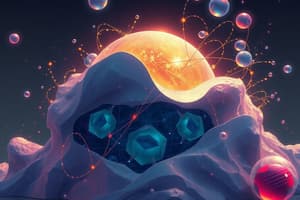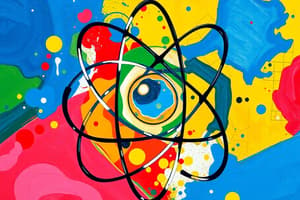Podcast
Questions and Answers
What is the purpose of the pH scale?
What is the purpose of the pH scale?
- To analyze the mass of different chemicals
- To measure the temperature of a solution
- To determine the concentration of a solute
- To measure the acidity or basicity of a solution (correct)
What does a mole represent in chemistry?
What does a mole represent in chemistry?
- A specific volume of a gas
- The weight of a substance in grams
- 6.022 x 10²³ particles of a substance (correct)
- The temperature at which a substance melts
Which statement correctly describes endothermic reactions?
Which statement correctly describes endothermic reactions?
- They occur only in solid-state reactions
- They involve no change in temperature
- They release heat to the surroundings
- They absorb heat from the surroundings (correct)
What is the role of a solvent in a solution?
What is the role of a solvent in a solution?
What is the main function of Safety Data Sheets (SDS)?
What is the main function of Safety Data Sheets (SDS)?
What characterizes a solid in terms of its physical state?
What characterizes a solid in terms of its physical state?
What is the primary focus of organic chemistry?
What is the primary focus of organic chemistry?
Which type of chemical bond involves the sharing of electrons?
Which type of chemical bond involves the sharing of electrons?
What does the atomic number of an element represent?
What does the atomic number of an element represent?
Which change of state occurs when a solid turns directly into a gas?
Which change of state occurs when a solid turns directly into a gas?
What type of reaction is characterized by the breakdown of a compound into simpler products?
What type of reaction is characterized by the breakdown of a compound into simpler products?
Which of the following describes acids?
Which of the following describes acids?
How are elements arranged in the periodic table?
How are elements arranged in the periodic table?
Flashcards are hidden until you start studying
Study Notes
Basic Concepts of Chemistry
- Definition: Chemistry is the scientific study of matter, its properties, composition, structure, and the changes it undergoes during chemical reactions.
- Branches:
- Organic Chemistry: Study of carbon-containing compounds.
- Inorganic Chemistry: Study of inorganic compounds, primarily those not containing carbon.
- Physical Chemistry: Study of the physical properties and changes of matter.
- Analytical Chemistry: Techniques and methods to analyze substances.
- Biochemistry: Study of chemical processes in living organisms.
Matter
- Definition: Anything that has mass and occupies space.
- States of Matter:
- Solid: Definite shape and volume.
- Liquid: Definite volume, but takes the shape of its container.
- Gas: No definite shape or volume, expands to fill its container.
- Changes of State:
- Melting, freezing, condensation, evaporation, and sublimation.
Atomic Structure
- Atoms: Basic units of matter.
- Composed of protons (+), neutrons (neutral), and electrons (-).
- Atomic Number: Number of protons in an atom, defines the element.
- Mass Number: Total number of protons and neutrons.
- Isotopes: Atoms of the same element with different numbers of neutrons.
Chemical Bonds
- Ionic Bonds: Formed through the transfer of electrons from one atom to another.
- Covalent Bonds: Formed when two atoms share electrons.
- Metallic Bonds: Bonding between metal atoms, involving a 'sea' of delocalized electrons.
Chemical Reactions
- Reactants and Products: Substances that undergo change (reactants) and the new substances formed (products).
- Types of Reactions:
- Synthesis: Combination of two or more substances to form one compound.
- Decomposition: Breakdown of a compound into simpler products.
- Single Replacement: One element replaces another in a compound.
- Double Replacement: Exchange of ions between two compounds.
- Combustion: Reaction with oxygen, producing heat and light.
The Periodic Table
- Organization: Elements arranged by increasing atomic number.
- Groups/Families: Vertical columns with similar chemical properties.
- Periods: Horizontal rows representing energy levels of electrons.
Acids and Bases
- Acids: Substances that donate protons (H+) in solutions.
- Bases: Substances that accept protons or donate hydroxide ions (OH-) in solutions.
- pH Scale: Measures the acidity or basicity of a solution (0-14 scale).
Stoichiometry
- Definition: Study of the quantitative relationships in chemical reactions.
- Mole Concept: A mole represents 6.022 x 10²³ particles of a substance.
- Balanced Equations: Conservation of mass is vital; the number of atoms must be the same on both sides of a reaction.
Thermochemistry
- Definition: Study of heat changes in chemical reactions.
- Endothermic Reactions: Absorb heat.
- Exothermic Reactions: Release heat.
Solutions
- Solvent: Substance that dissolves another substance (usually liquid).
- Solute: Substance that is dissolved.
- Concentration: Amount of solute in a given volume of solvent (often expressed in molarity).
Key Lab Techniques
- Titration: Method to determine the concentration of a solution by reacting it with a standard solution.
- Chromatography: Technique for separating mixtures based on different interactions with a stationary phase.
Safety in Chemistry
- Personal Protective Equipment (PPE): Use of gloves, goggles, and lab coats.
- Safety Data Sheets (SDS): Provide information on handling, hazards, and emergency measures for chemicals.
These notes provide a foundational understanding of key concepts in chemistry and can be expanded upon with more detailed study in specific areas.
Basic Concepts of Chemistry
- Chemistry studies matter, its properties, composition, structure, and changes in chemical reactions.
- Five main branches of chemistry:
- Organic Chemistry examines carbon-containing compounds.
- Inorganic Chemistry focuses on inorganic compounds, generally lacking carbon.
- Physical Chemistry looks at the physical properties and changes of matter.
- Analytical Chemistry involves techniques to analyze substances.
- Biochemistry studies chemical processes in living organisms.
Matter
- Matter is anything with mass that occupies space.
- Three states of matter:
- Solids have a definite shape and volume.
- Liquids have a definite volume but take the shape of their container.
- Gases have no definite shape or volume, expanding to fill their container.
- Changes of state include melting, freezing, condensation, evaporation, and sublimation.
Atomic Structure
- Atoms are the basic units of matter, consisting of protons (positively charged), neutrons (neutral), and electrons (negatively charged).
- Atomic Number indicates the number of protons and determines the element identity.
- Mass Number is the sum of protons and neutrons in an atom.
- Isotopes are variants of the same element differing in neutron count.
Chemical Bonds
- Ionic Bonds form through electron transfer between atoms, creating charged ions.
- Covalent Bonds arise when two atoms share electrons.
- Metallic Bonds feature delocalized electrons, allowing conductivity and malleability among metal atoms.
Chemical Reactions
- Reactants are the starting substances, while products are the new substances produced from a reaction.
- Types of reactions include:
- Synthesis: Multiple substances combine to form a single compound.
- Decomposition: A compound breaks down into simpler substances.
- Single Replacement: An element replaces another in a compound.
- Double Replacement: Two compounds exchange ions.
- Combustion: A reaction with oxygen that yields heat and light.
The Periodic Table
- Elements are organized by increasing atomic number.
- Groups or families are vertical columns indicating similar chemical behaviors.
- Periods are horizontal rows signifying the arrangement of electrons in energy levels.
Acids and Bases
- Acids donate protons (H+) in aqueous solutions.
- Bases accept protons or donate hydroxide ions (OH-) in solutions.
- The pH scale, ranging from 0 to 14, measures solution acidity or basicity.
Stoichiometry
- Stoichiometry explores quantitative relationships in chemical reactions.
- The mole concept defines a mole as 6.022 x 10²³ particles of a substance.
- Balanced Equations are essential for mass conservation, maintaining equal atom counts on both sides of a reaction.
Thermochemistry
- Thermochemistry studies heat changes during chemical reactions.
- Endothermic Reactions absorb heat from their surroundings.
- Exothermic Reactions release heat to their surroundings.
Solutions
- A Solvent dissolves another substance, typically a liquid.
- A Solute is the substance that gets dissolved.
- Concentration measures the solute amount in a given solvent volume, often expressed in molarity.
Key Lab Techniques
- Titration is used to determine solution concentration by reacting it with a standard solution.
- Chromatography separates mixtures based on different interactions with a stationary phase.
Safety in Chemistry
- Personal Protective Equipment (PPE) such as gloves, goggles, and lab coats is crucial for safety.
- Safety Data Sheets (SDS) provide essential information on chemical handling, hazards, and emergency protocols.
Studying That Suits You
Use AI to generate personalized quizzes and flashcards to suit your learning preferences.




